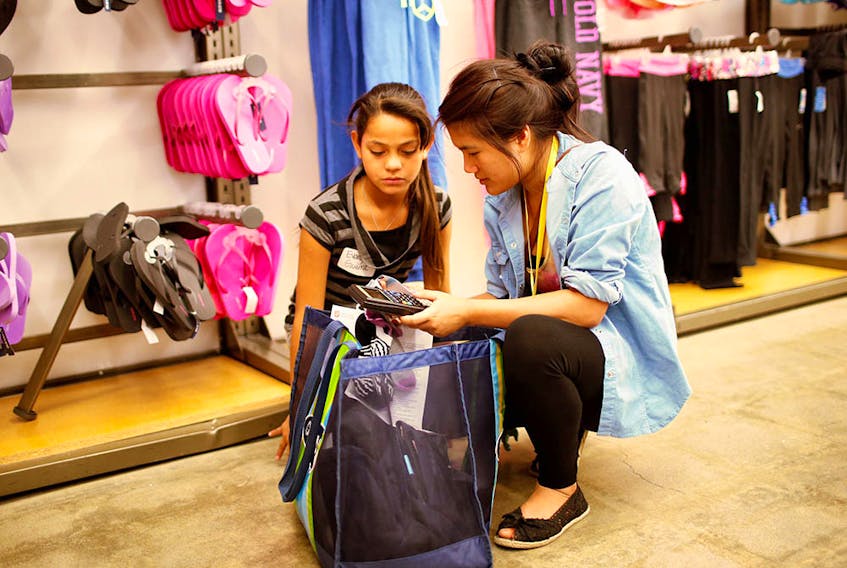Q: A parent asked a question about back-to-school shopping on our school’s Facebook page last week. With all that has been going on, I honestly hadn’t even thought about it yet, even though it’s something my kids and I enjoy doing every year. I’ve been more worried about keeping my kids healthy and mostly happy. I’ve had to start working a second job because the one I had doesn’t pay enough anymore. My ex is thankfully back to work and can start paying his child support again. Even with my mom helping out with daycare for my younger two, there still isn’t a lot of money for back-to-school shopping. I feel bad not being able to buy very much for my kids because they’ve already done without so much since COVID started, but I can’t afford a big bill right now. What can I do? ~Leanne
A: The pandemic has thrown many of us the biggest curveball we’ll likely ever face. Those with school-age children have the added stress around the ongoing uncertainty about what schools will look like come September. But eager for a sense of normalcy and some retail therapy, many parents and kids have been looking forward to doing some back-to-school shopping. For the sake of your budget and your sanity, this might, however, be the perfect time to break the ritual of spending that has become so firmly attached to the tradition of shopping for back to school.
The pandemic changed our money habits
Through these uncertain times, many Canadians felt a certain amount of fear around money. It is important, however, that fear around money isn’t the main lesson that sticks with our kids. We want to instead equip them with the skills and confidence to make good decisions, even during unpredictable times.
By watching their parents during the pandemic, many children saw how much more efficient their parents had to become with their money and resources. Out of necessity they budgeted what they earned more carefully, became more resourceful with what they already had, and planned ahead in case they couldn’t buy or do as they normally did.
While we didn’t necessarily explain to our children what we were doing in the midst of all that uncertainty, back-to-school shopping is a great opportunity to take a step back and reinforce positive lessons the pandemic taught us about money.
How to Get the Most Out of Your Back-to-School Budget
Spending lessons for kids with back to school shopping
One way to pass along to our kids the money lessons we learned from the pandemic is to involve them in age-appropriate decisions that go with what they need and want for back to school. Just like learning to read, kids need to practise making spending choices and using money so that they get good at it. And the key is to start early if you want your kids to make responsible financial choices once they’re in control of their own money.
For young children, allow them to help choose their pencil case and backpack. As they get older, help them compare price and quality as they look at their supply list. Once they can add and subtract easily, give them a set amount of money and help them as they choose what they need and can afford within that limit. When they become teens, provide a limit as to how much you can afford for what they need and want, and then support them as they either shop within their allotted budget, or as they look for ways to earn a little extra cash to top up what you’ve given them. Learning how to balance priorities and make reasonable choices takes time and practice.
Smart Back to School Shopping Tips That Save You Money
Teach your kids to be resourceful with what they have
We love our stuff and often pay dearly for it; it’s no different for our kids. However, one thing many people came to realize during the pandemic is how much they already have. This goes hand-in-hand with how we budget our money because when we realize how much we have and become resourceful with it, we tend to buy less.
Before you shop for more school supplies, sit down with your kids to see what they already have. This is your opportunity to help them distinguish needs from wants. Encourage them to reuse a favourite binder or pencil case. If a device they need isn’t working properly or needs a new charging cable, set the item aside so that you don’t forget to attend to it. If you know you’ve got several kids needing pencil crayons, it can be worth buying an electric pencil sharpener to get old pencil crayons ready for this year.
If you have kids in several grades, you likely have almost everything they need at home to at least start school in September. Take advantage of some sales at this time of year to stock up on what you know you’ll run out of, but resist the temptation to buy everything brand new that’s on the school supply list.
What’s the Best Way to Handle Credit Card Debt?
New school supplies when money is tight
Kids don’t need everything on the first day, especially when we aren’t yet sure what the first day will look like, so plan what to buy later. You might even want to turn some items into birthday or Christmas presents. Extended family members could be encouraged to chip in towards the larger items, like expensive clothing, shoes, or electronics — all of which can ring up quite the bill.
If your kids need specific electronics, like a laptop, to do their schoolwork at home, ask the school if there’s any help available to get what you need. Sometimes they have devices that can be borrowed or a small budget to help buy what you need. Retailers also sell refurbished items at reduced prices or offer educational discounts.
Resist the Urge to Buy Impulsively When Looking for Good Deals
If you have loyalty or rewards points, trade them in for cash, discounts or items on your back-to-school shopping list. Saving money on what you need now means less money owing on a credit card. You’ll be further ahead in the long run without all the extra interest that comes with carrying a balance from month to month.
If you’ve got teens who are old enough to have a part-time job, help them set savings goals so that they can contribute to the cost of what they need and want. This helps them learn the value of money, how to budget, and how to plan for the future. You can also help them examine their motivations behind the purchases they want to make, weigh any pros and cons, and look for deals. Teens who have the chance to learn how to earn, spend, save and make up for their own mistakes tend to manage credit better once they’re old enough to have a credit card.
Budget Planning for Teens Getting Their First Paycheques
The bottom line on teaching kids about money during a pandemic
Teaching our kids about money helps them learn a valuable life skill. Once high school is over and our young adults prepare to move on to the next stage of their life, we hope that they’ll be able to manage their money and make reasonable choices. In reality, the school of hard knocks teaches many of them some tough lessons. Falling prey to sophisticated marketing, high expectations of what they “should” buy, and giving in to wants before needs is an expensive way to start managing their own affairs. Draw on what the pandemic taught you about money and keep working together with your kids to learn money skills. It’s an education your kids might not get anywhere else.
Related reading:
How to Balance Your Back to School Budget with Needs and Wants
Practical Money Tips for Post-Secondary Students
The 7 Smartest Things You Can Do for Your Finances
Scott Hannah is president of the Credit Counselling Society, a non-profit organization. For more information about managing your money or debt, contact Scott by email , check nomoredebts.org or call 1-888-527-8999.
Copyright Postmedia Network Inc., 2020








